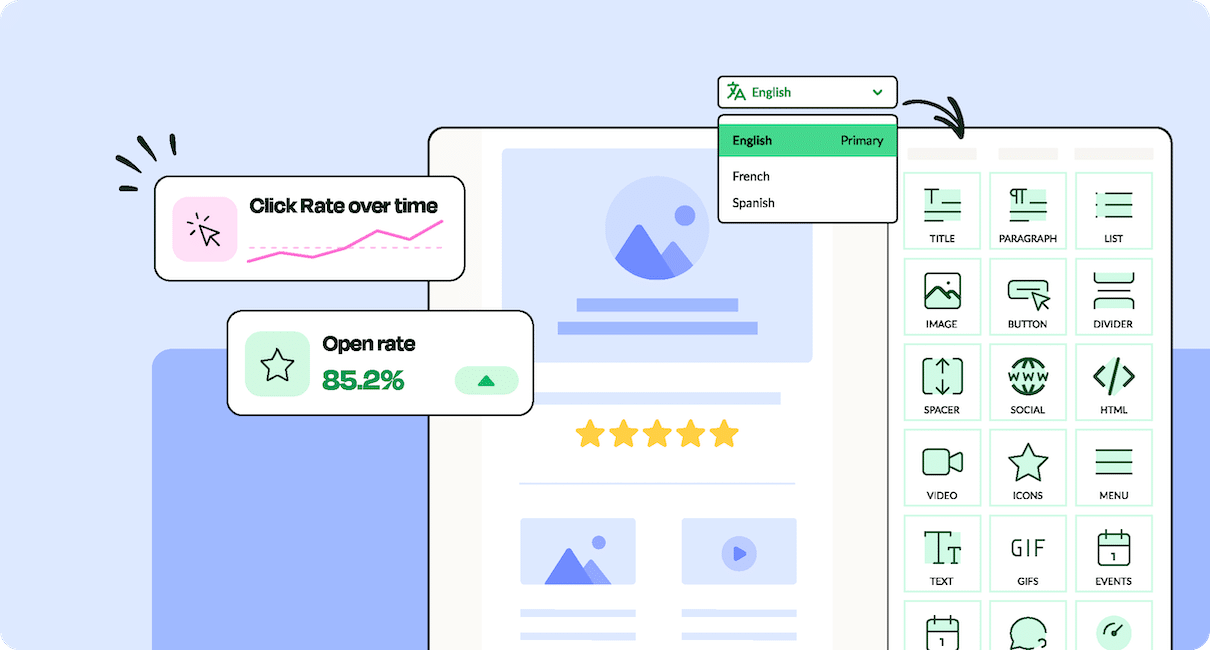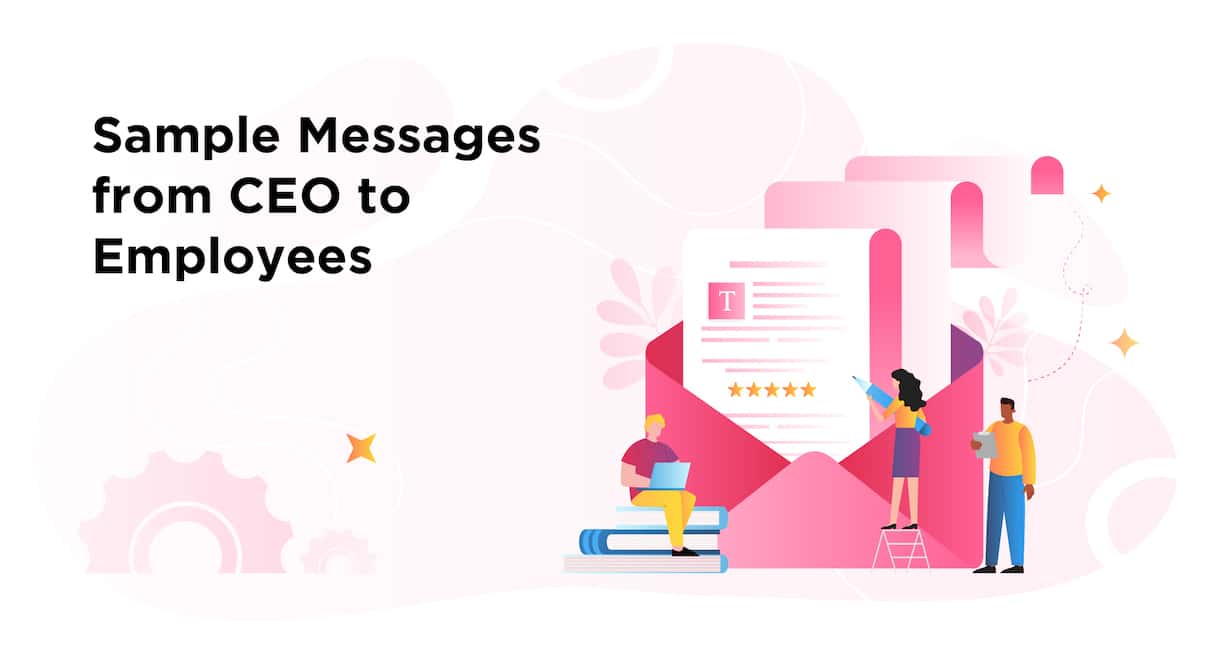Outstanding leadership has always hinged on effective communication. However, when communication channels are numerous and the workplace is no longer just a pinpoint on a map, leadership communication is more important than ever.
Teams with solid leadership are more resilient to the challenges that face to them.
Today, leaders must connect and guide workers and facilitate employee engagement across fully remote and hybridteams. This means recognizing the importance of effective email communication while retaining the human element of face-to-face interaction.
By staying informed about the latest trends and industry insights, you can make leadership communication your company’s most vital asset.
See how ContactMonkey’s internal communication solutions can help you improve your leadership communication.
Take a self-guided tour of ContactMonkey
See how our key features can streamline your internal communications.
Take product tour

What Is Leadership Communication?
Leadership communication is the process of strategically planning and delivering messages that inspire, guide, and engage employees and key business stakeholders.
There’s a lot that goes into effective leadership communication. Thinking and planning with clarity, expressing ideas in a way that captivate audiences, and information accessibility are just a few key components.
Most importantly, leadership communication should be able to foster a sense of trust in the workplace and its leaders.
Why Is Leadership Communication Important in The Workplace?
The importance of leadership communication lies in its ability to create alignment between employees and keep them engaged.
Effective leadership communications unite teams behind common goals and values.
In times of difficulty, your leadership communications should provide motivation and direction for employees as well as boost employee morale. When it’s business as usual, their job is to keep employees aligned with the company mission and vision.
Poor communication from your leaders leads to employees feeling left out of important company updates, undervalued as employees, and ultimately—disengaged.
If you’re interested in strengthening your leadership capabilities, we’ll break down how it’s done below.
How To Improve Leadership Communication
When your goal is to enhance your leadership communication, the process introduces a particular set of goals that are distinct from general communications.
Leaders need to speak and act with purpose. They should know not just what to communicate, but consider which situations call for specific channels, how to convey authenticity, and when to ask for and collect feedback.
It’s also important to consider the frequency with which leaders communicate with their whole team, and the tone they want to set.
When developing a plan to improve your leadership communications, consider these priorities:
- Encouraging collaboration and team-building
- Making communications accessible to all
- Leveraging different communication channels for different purposes
- Aligning employees with company values and goals
- Fostering trust in the office
- Keeping employees continuously informed
- Creating an inspiring vision that employees can look to
- Promote two-way communication streams
- Always encourage employee feedback
Modern internal comms and measurement tools
No design or technical expertise needed. Save time, increase engagement, and dazzle your employees with fun and interactive communications.
Explore all features

20 Leadership Communication Trends and Best Practices
Now that we’ve answered the question of ‘why is communication important in leadership?’ let’s look at tangible ways to improve it.
To say that leadership communication has made strides in the last few decades would be an understatement. From the emergence of platforms like Slack and Zoom to interactive internal communications software and email tracking, there’s been lots of innovation.
To keep pace with the shifting landscape of leadership communication, it’s important to stay on top of trends while revising some of the tried and trusted strategies.
We break them down below:
1. Honesty and authenticity
Trust is the building block of strong company culture. But you can’t expect your employees to trust leaders who say all the right things without an ounce of integrity.
Employees want to know that their leaders are real people who understand their challenges because they also faced, or continue to face them.
Honest and authentic communication happens when words match actions and when leaders can speak with humility.
That means, if there’s a major issue in the company or a mass layoff, leaders need to take accountability. At the same time, when there’s success, leaders need to recognize individual employees that made it happen.
2. Implementing transparency
Transparency is a word that gets thrown around a lot in the corporate world. So much so, that we often forget what it actually means in practice.
Leaders who exercise transparency continuously practice what they preach. They outline their expectations and workplace standards clearly, and offer themselves up to feedback and questions regularly.
This ethos should extend to hiring and recruitment practices, salary expectations, and any challenges the company may be facing.
When leaders are an open book, a culture of open communication starts to develop across your whole workplace.
3. Creating an internal communications plan
Even though organizations are increasingly recognizing the significance of internal communications for their organization’s success, many are still lacking a solid internal communications strategy.
For effective leadership communications to happen, they need to integrate smoothly with the rest of your internal messaging.
Whether an email is coming from your HR team, your internal comms team, or directly from senior execs, it needs to showcase a unified front and organized messaging.
Having an internal communications plan ensures that your leaders have a cadence and frequency to their messaging.
Equally important is for your communications to stay on brand and accurately represent your brand identity, style, tone and values.
With ContactMonkey’s custom branding, you can ensure that all your leadership email communications are consistently on brand.
Unlock Internal Comms Superpowers
Discover why 10,000+ rely on us. See the internal email and employee newsletter platform in action.
Book demo

4. Aligning employees with strategic goals
It’s the job of a good leader to ensure organizational alignment across their teams. This guarantees commitment to shared business values and a single, powerful company mission.
That being said, many companies still face a lot of employee misalignment. The result: friction between teams and ultimately, disengaged employees.
Your leadership communications need to make your company’s vision, strategic goals, and overarching mission, clear and compelling. Employees will feel like they’re truly working towards a common objective and collaborate more effectively.
5. Getting personal
It goes without saying that effective leadership communication can’t just be a monologue. When that’s the case, your leaders will look like they’re placed on a pedestal—cold and disconnected from their staff.
If your goal is to develop meaningful relationships with and among your employees, then dialogue in your leadership communications is key.
You can achieve this by including more questions and personal anecdotes in leadership messages to employees.
Comment boxes and feedback options alongside leadership communications are also useful. This creates a more personal and conversational tone to the messaging and makes it feel engaging and authentic—and can be a great source for employee engagement ideas.
With ContactMonkey, you can also ensure that your leadership emails are always sent on behalf of senior execs while still using your internal comms team’s email template builder.
After you’ve installed the ContactMonkey plugin, all you have to do is choose your preferred sender and distribution right from Google or Outlook.
6. Being specific
Clarity is essential for effective communication. A lot of the time, senior leaders become well-versed in industry jargon and start using it to communicate with staff.
But being clear, concise, specific, and straightforward in your communications will pay off much more. That’s especially the case today when employees are often juggling multiple messaging platforms and communicating across countless teams.
If you want to improve your leadership communications, trim the corporate talk and stick to the basics.
You can further ensure your employees understand your emails by only sending them relevant information. Use custom email lists to target relevant audiences and exclude others to increase email engagement and reduce irrelevant emails.
With ContactMonkey’s List Management feature, you can easily create your own custom email lists without needing IT. Lists created with ContactMonkey integrate with your Human Resource Information System (HRIS) like Workday and ADP, as well as Azure Active Directory, so they’ll automatically update as employees join and leave your organization.


7. Showing empathy
When leaders are good at recognizing and understanding employees’ point of view and experience, their teams feel valued and heard. Those employees end up staying longer with the company and becoming it’s biggest advocates.
Still not convinced? Let’s look at the numbers. Research shows that almost 96% percent of employees believe it’s important when their leaders show empathy.
If your goal is to enhance your communication by engaging more employees, start showing a little empathy. That means sharing personal stories of professional challenges and career growth.
It also means recognizing a team’s efforts even when they failed to close on a client by highlighting the lessons learned and underscoring how these can become assets when closing bigger and better deals.
8. Keeping an open mind
A closed mind is often the one thing that stands between good and outstanding leaders. When a closed mind is met with a challenge, it too often turns to the age-old solutions—which work until they don’t.
To keep pace with the digital transformation of the modern workplace, having an open mind and trying the new and unknown is essential.
At the same time, when leaders showcase this quality, they invite employees to share daring and innovative ideas, which they may have otherwise felt uneasy to share.
Once a leader shows that she is open to listening to new ideas or hearing out opposing opinions, they gain greater respect across the organization. It also demonstrates their capacity to listen, learn, and continuously grow.
9. Active listening
A big yet understated component of effective leadership communication is the ability to simply listen. Great leaders don’t need to put much effort into this endeavour—they have an intuitive desire to understand and learn from others.
But demonstrating active listening involves more than simply hearing someone out. It sends employees the message that their opinions and input matter.
Leaders can showcase this trait both during in-person, and email communications.
A good way to start is by giving back a brief summary of what an employee said or wrote to show that their point was heard and understood.
When responding, start by highlighting what you value in the points brought up. If you have an opposing viewpoint, present it in a question style and ask for feedback.
10. Hearing what’s not said
While active listening will help you engage more meaningfully with employees, there are still some things your staff may not feel comfortable sharing with senior execs.
Strong leaders can read between the lines and go beyond surface-level dialogue to truly understand what may not be said directly.
Say a group of employees is dissatisfied with a team leader or wants more transparency from managers. Effective leaders need to be attuned to this.
But unless you’re a mind reader it can be tricky to read between the lines through a single interaction with a group of employees. Especially if said interactions are virtual, as many are nowadays.
In order to truly stay in tune with employees, leaders need to communicate frequently. Picking up on subtle cues becomes simpler when you’re constantly engaging with your employees.
In addition, anonymous surveys can provide leaders with feedback on more sensitive topics and allow employees to express themselves honestly and authentically.
ContactMonkey’s anonymous surveys embed directly into your employee emails. So you get honest and valuable feedback consistently and with ease.
11. Speaking to groups as individuals
Effective leadership communication involves tailoring messages to different audiences so that they feel more personal. And that goes for any audience size.
With the advent of tools like merge tags, there’s no excuse for making communications that aren’t tailored to your audience. By personalizing messages, your leadership communications will be more successful at building rapport with employees.
With ContactMonkey’s mail merge feature, you can easily schedule and send personalized employee messages. Automatically add employee names to the subject line and send to your desired distribution lists directly from Outlook or Gmail:
12. More tailored content
Considering that the average employee receives over 121 emails a day, it’s no surprise that 71% of employees don’t actually read your company’s internal communications.
Any good external marketer knows the power of content to drive audience engagement. Internal marketing works similarly. By creating content tailored to employee interests and preferences, you can see visible spikes in engagement.
If you’re struggling to come up with compelling content for your emails, try using ContactMonkey’s OpenAI ChatGPT integration to generate new ideas for your email content. Simply describe what kind of content you’d like to create, generate example text, and edit it according to your needs.
To start, dive into the analytics behind your leadership communications first. With the best email tracking software like ContactMonkey, you can see exactly which types of content employees engage with the most.
Open rates, reading times, and click-through-rates will give you tangible insights on what content your teams enjoy the most. Leverage those insights to create content that truly resonates with your audiences. If you see that videos receive more clicks than other types of embedded resources, start creating and sharing more video content.
If you have internal or external regulations around email privacy, you can use ContactMonkey’s anonymous email tracking to gather email metrics while maintaining your employees’ privacy.
Create internal emails that get opened and read
No design or technical expertise needed. Save time, increase engagement, and dazzle your employees with fun and interactive communications.
Explore email features

13. Developing an effective content strategy
When it comes to leadership communications, having engaging and tailored content is only the first step to a successful internal content strategy.
Equally important is planning, organizing, and scheduling your content effectively.
Having a cadence to your leadership communications gives employees an idea of what to expect and when. You’re also able to target specific times of day and days of the week when employees are more likely to open your communications.
With an internal communications tool like ContacMonkey, you can gather in-depth email analytics and use them to plan and schedule your content.
In your ContactMonkey dashboard, you’ll see when and even in which departments employees engage with your content.
You can tailor your sending times and even the content itself to reflect the analytics. With the scheduled send feature, you can plan and prepare your communications well in advance. So no matter what your leadership team or internal communications pros have on their plate, key messages are ready to go out on time.
What’s more is that your internal communications team has the ability to send messages from different users, including on behalf of leadership, and measure employee engagement from these messages.
14. Reaching all employees
Making sure that vital resources, such as change management updates, reach every single employee is a vital part of effective leadership communications. But it can also be the most challenging.
In fact, over 60% of employees expressed that they either occasionally, or always don’t open work emails. This statistic is alarming but there are ways to sidestep the problem.
By using an internal email tracking tool, you can see exactly who opened your internal emails, which resources they click on, and even reading times.
This functionality is available with ContactMonkey, alongside our campaign comparison feature which lets you see email analytics for different campaigns side by side. You can determine what type of content resonates more and less while targeting engagement issues.
15. Ensuring mobile-friendly employee communication
For better or worse, employees rely on their phone a lot.
In fact, cell phones are the most-used device by employees both at home and in the workplace. And it’s no surprise given that today’s workforce is increasingly made up of millennial and Gen-Z employees who grew up in a tech-driven world.
In fact, when it comes to departments like IT, Nearly 80% of executives say employees cannot do their jobs effectively without a mobile device.
Want numbers that are more specific to your workplace? With an email tracking tool like ContactMonkey you can see on which device your employees are most likely to open your messages.
For peace of mind, use ContactMonkey’s responsive HTML email templates. They’ll ensure that all your leadership email communications display properly on any device and never distort.
Get powerful email analytics and reporting features
Know exactly who is opening and engaging with your employee communications and company newsletters.
Explore analytics & reporting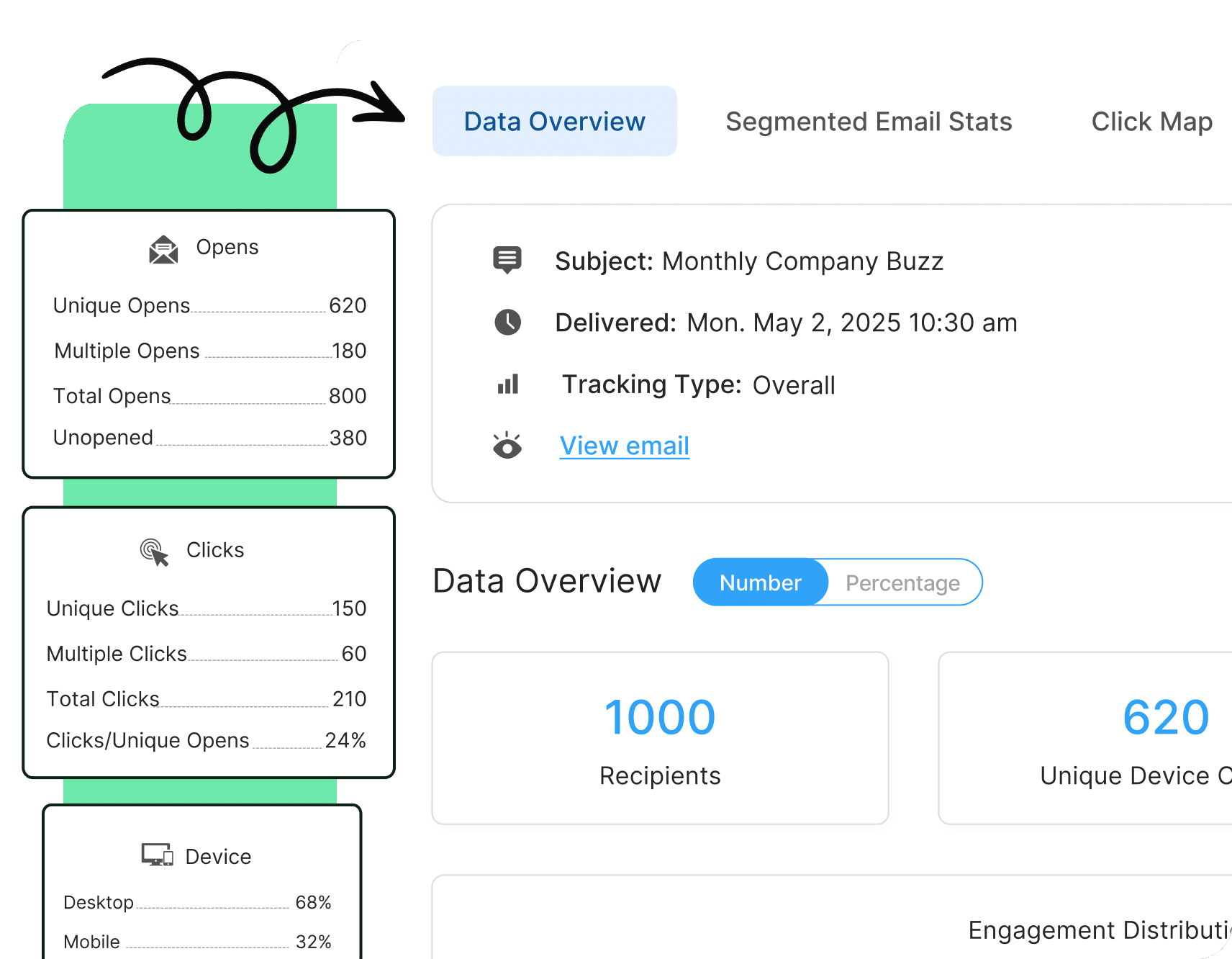
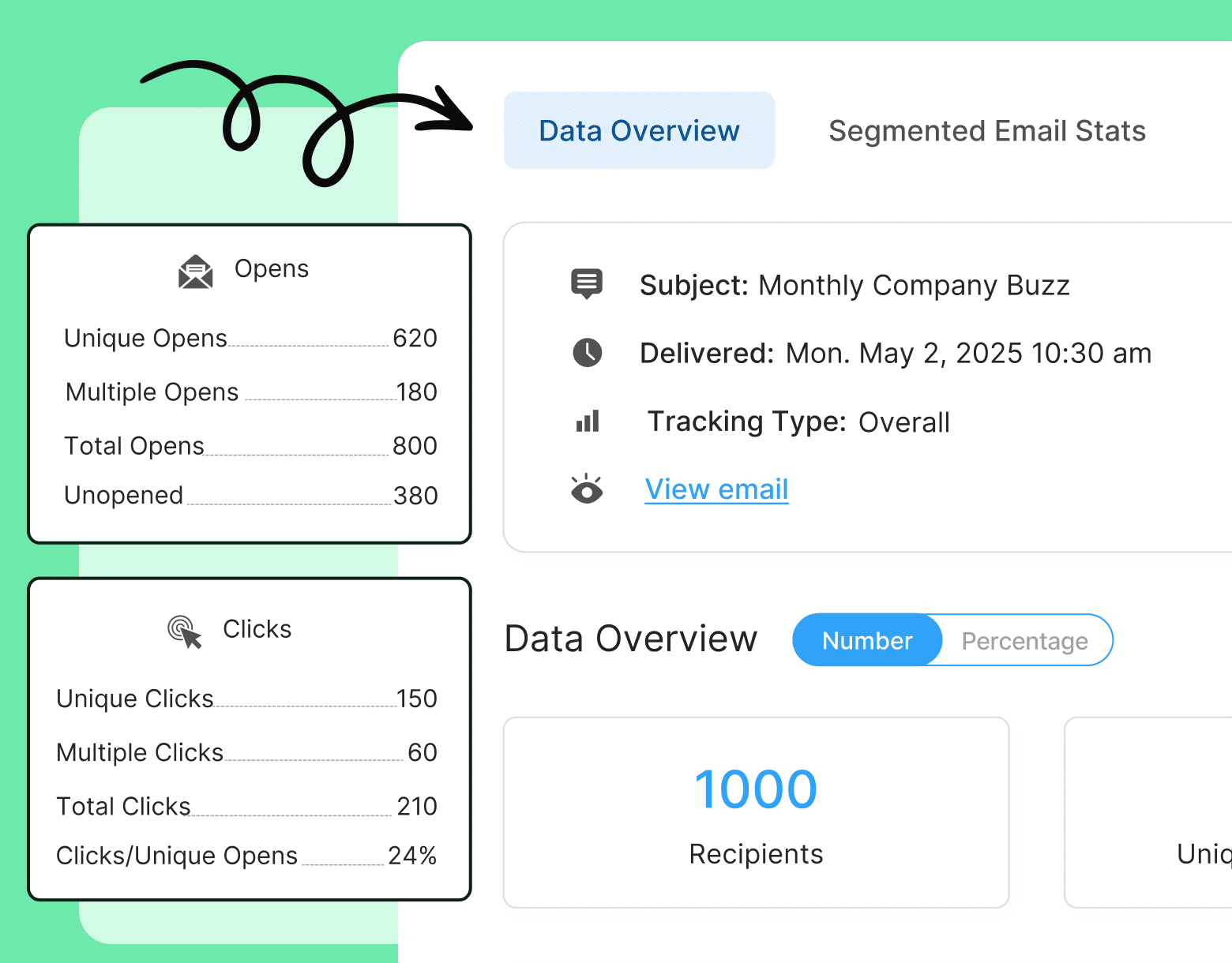
16. Promoting bottom-up conversations
Having a platform for your voice also brings with it the responsibility to share the stage with others. Great leaders know the importance of giving voice to others and encouraging bottom-up conversations.
However, research shows that only half of employees feel like they’re able to speak their mind at work.
Help employees who don’t traditionally speak up, by asking questions during virtual town halls, addressing specific teams, and adding pulse survey questions at the end of your leadership emails. You can also use employee recognition as an invitation for employees to speak up by highlighting their achievements during a town hall or in an employee of the month feature in your newsletter:
17. Building a collaborative workplace culture
Effective leaders are able to foster effective collaboration and team-building. And they do that by aligning teams and getting all employees on the same page.
Leaders should also set an example through the way they communicate, ask questions, and listen to others’ opinions.
If you want your staff to show respect and consideration for each other’s ideas, lead by example. At the same time, use your leadership communications to promote company values and goals so that every staff member has the same mission top of mind.
18. Making all information accessible
Accessibility remains a big problem when it comes to internal communications in many organizations. Vital information gets lost and never reaches employees.
This not only leads to higher risk of employee disengagement, but can be an all-out hazard if the lost information regards things like safety training.
Lack of accessibility in your leadership communications can also impact productivity if employees can’t access key updates or resources to do their job.
In order to avoid this, ensure that your leadership communications leverage multiple channels and are synchronized across each one.
Your newsletter should promote and link back to your employee intranet or employee chat and vice versa. This way, if employees miss communications on one platform, they can access it from another.
19. Turning employees into brand ambassadors
Your company has accomplishments to be proud of. So brag about them a little bit.
It will help get employees excited about the organization’s future and show that their collaborative efforts are paying off.
Use your employee newsletter to showcase team achievements, forecast successful quarters, and demonstrate how your current company trajectory is leading you to even bigger success down the road.
With ContactMonkey, you can create employee achievement features in your internal newsletter. Then, add comment boxes and reactions so employees can engage in dialogue, give props, and share in the celebration.
If you want to check if your employees are on their way to becoming brand ambassadors, ask quick staff survey questions or conduct an eNPS survey. ContactMonkey’s Employee Net Promoter Surveys embed straight into your employee emails to ask a single, focused question:
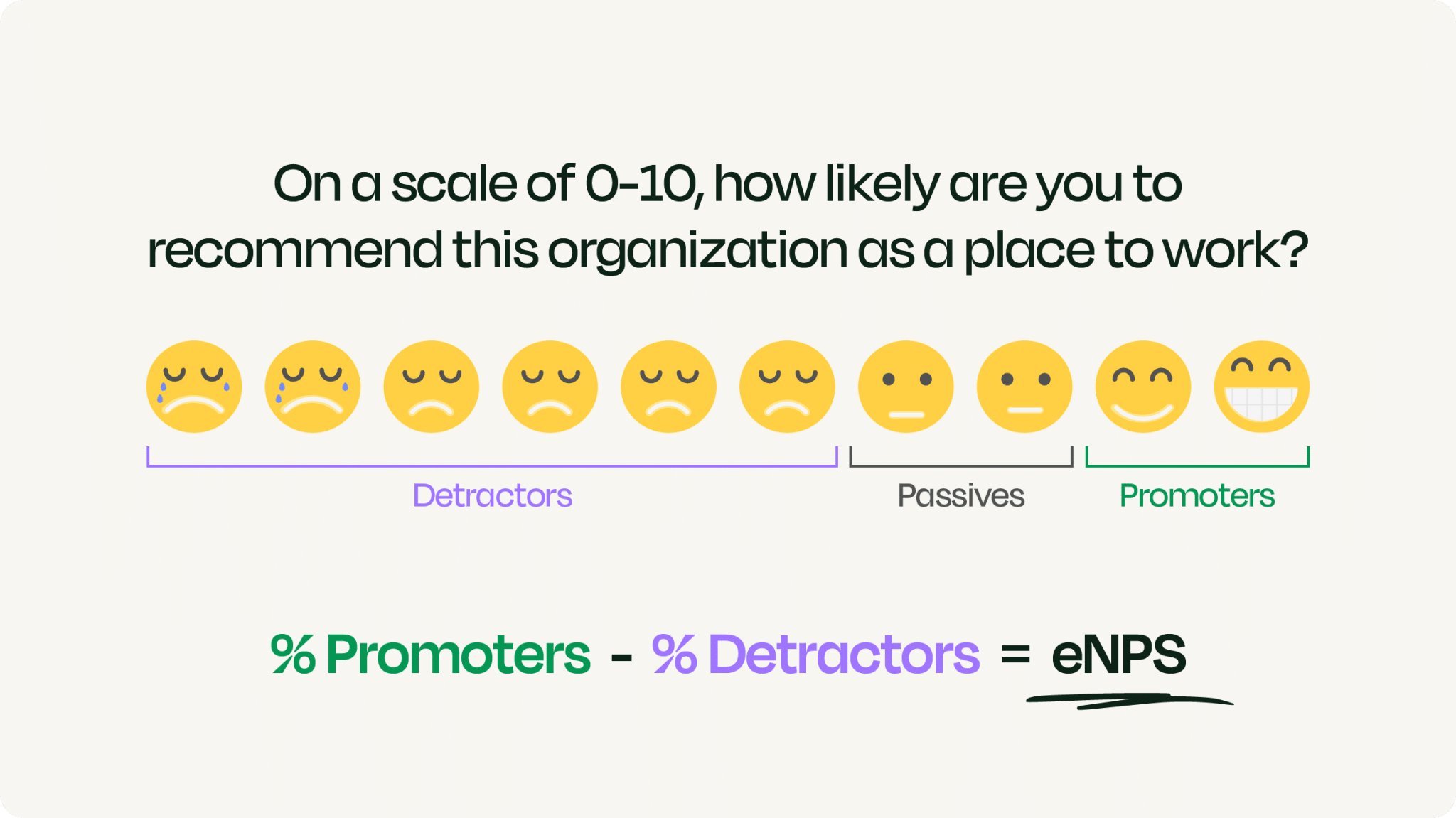
20. Using data to measure the effectiveness of leadership communications
When it comes to leadership communications, the biggest benefit of today’s technology advances is the promise of in-depth analytics.
Leaders can now get concrete data on the effectiveness of their messaging and see how well they’re doing. This empowers today’s leaders to make data-driven changes and tailor their leadership communications to a transformed post-pandemic workforce.
ContactMonkey’s internal email software drives on data. Everything you send using our tool is measurable and comes with visualized data. So you can always inform your messaging and continue to keep pace with the changing trends in leadership communications.
Enhance Your Leadership Communication With ContactMonkey
When you cut corners in your leadership communication, employees take notice. To strengthen your messaging and boost employee engagement, you need to keep pace with the changing trends in leadership communications. By reinforcing the best practices in this post with a powerful internal communications tool, you’ll be able to see tangible results.
Here’s how ContactMonkey’s internal communication tool can help with your leadership communications:
- Create responsive HTML emails
- Choose from dozens of email templates
- Customize your email template using simple drag-and-drop elements
- Set brand guidelines for all communications
- Embed pulse surveys and anonymous comments
- Send communications on behalf of leadership from a single mailbox
- Use mail merge for personalized communications
- Schedule and customize sending times
- Gain more in-depth and reliable email analytics
With ContactMonkey, your leadership communications are always backed by data. Book a free demo to learn more about ContactMonkey’s in-depth analytics, dynamic email template builder, and how you can create personalized, tailored, and targeted leadership communications.
